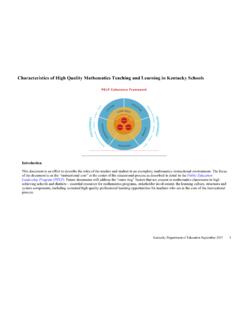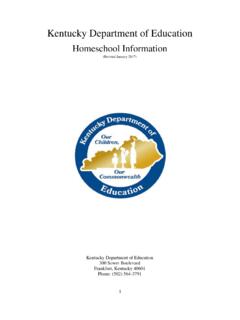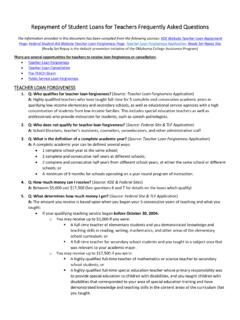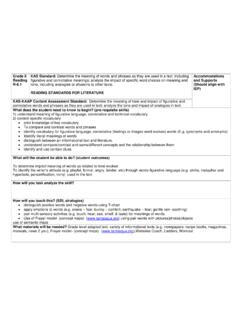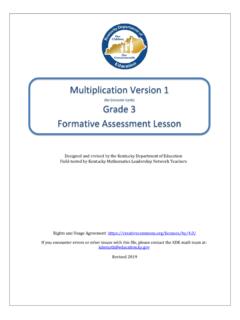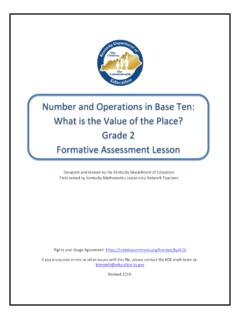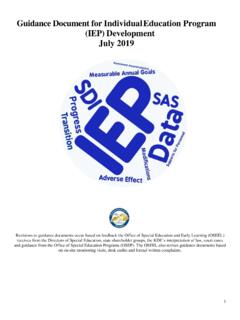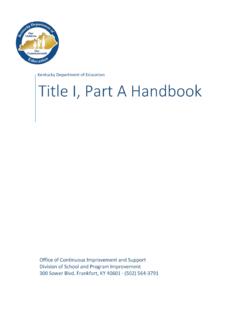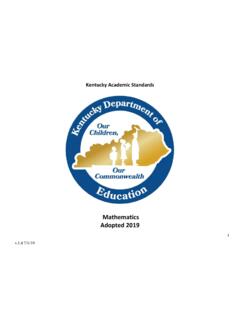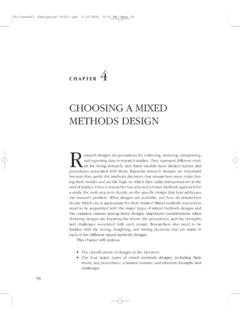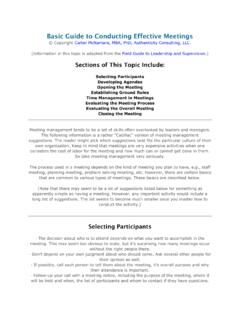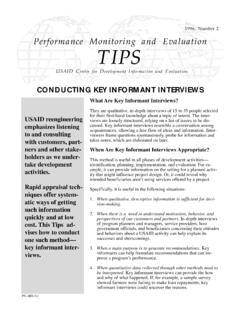Transcription of Tool 3: Conducting a Needs Assessment - Kentucky
1 District Name Facility Name Contact Tool 3: Conducting a Needs Assessment This set of resources provides basic tools and frameworks that follow the steps of the Needs Assessment process for States, subgrantees, or facilities to adapt as needed. Note: There are several points in time when State educational agencies (SEAs) and State agencies (SAs) should assess the educational Needs of the children and youth being served under Title I, Part D, such as: developing the State Plan (see Section 1414(a)(1)(A)); developing the SA Application (see Section 1414(c)(1)); implementing an institution-wide project (see Section 1416).However, Needs assessments may occur at any point in time by any agency or facility for program planning and improvement purposes; it is not an activity that is limited to Subpart 1 alone. Purpose of the Tools Conducting a Needs Assessment can be overwhelming.
2 These tools provide a starting point for those working with Title I, Part D, programs and undertaking a Needs Assessment . They are intended to assist administrators and Assessment team members as they work through the process. All of the tools can be used in isolation or as a set and are designed to be flexible and customizable in order to meet the goals of individual Needs assessments. These tools do not reflect any mandatory Title I, Part D, requirements. the Scope of the Assessment and Developing a Team: Use to determine why the Needs Assessment is being conducted, the goals of theassessment, and to identify who should be involved in the Needs Assessment Questions and Summarizing Data for the Program Overview: Once the goals of the Assessment are understood, use this worksheet to identifythe questions that need to be answered and help summarize the findings. and Using the Data: Reference these questions throughout the Assessment process from identifying data, to gathering data, to reviewing data to determine if the available information is useable, or if more data are Needs and Setting Priorities: Use this template to help determine which Needs to focus on first when several are on how to use these tools are provided with each individual tool.
3 Title I, Part D, Program Administration Planning Toolkit Tool 3 1 Needs Assessment 1: Identifying the Scope of the Assessment and Developing a Team Needs assessments can be conducted for a variety of reasons and at different levels by the SEA, SA, LEA, or facility. They can focus on a single area of interest ( , transition) or take a broader perspective to identify gaps throughout a system. Understanding the purpose, goals, and scope of the Assessment is c rucial t o all the remaining steps of the process. How to Use This Tool Respond to the following questions at the beginning of the process to determine the goals of the Assessment and who should be involved. Type up responses and share them so all stakeholders are in agreement before the Assessment process begins. Refer back to t hese responses when questions about scope and priorities arise later in the Assessment process.
4 Determining the Purpose and Scope of the Assessment Understanding the purpose of the Needs Assessment will help focus the scope and detail of the Assessment effort and help determine the time and resources (staff, budget, etc.) needed. Having this information will help when recruiting the Assessment team and/or explaining the Assessment to others. 1. What entities are requesting and guiding the Needs Assessment ? What level of programming is being assessed (State programs, district programs, individual facilities)?2. What is the purpose and scope of the Needs Assessment ? Why is the Assessment being conducted? What are the targeted goals or expected outcomes of the Assessment ? What are the specific topics or areas of interest (focused vs. comprehensive overview)?3. What entities will need to assist in providing information and data for the Needs Assessment ?Title I, Part D, Program Administration Planning Toolkit Tool 3 2 4.
5 What resources are required to conduct the Needs Assessment ? Who should be involved? Are outside resources/consultants needed? How long will the effort take given the scope of the Assessment ? What will the budget allow for?Establishing a Needs Assessment Planning Team The planning team will lead the process of Conducting the Needs Assessment . The members of the planning team will depend on the level at which the Assessment is being conducted (SEA, SA, LEA, or facility) and on the focus of the Needs Assessment . Depending upon the purpose and the scope of the Assessment , identify individuals who should be involved in the Assessment team. Establish a team leader who pulls the larger team together and directs the Needs Assessment process Make sure the team is comprised of individuals who have a variety of skills or knowledge and who can actively contribute to one or more aspectsof the Needs Assessment process, such as the.
6 Ability to request and obtain data and resources, ability to analyze and synthesize the data, or access to a team of people who can assist with this ability to prepare a report and develop action items ability to act on the results once the action items are identified ability to represent a unique perspective ( teachers, parents, students) of all impacted groups Ensure a cross-section of individuals (as applicable) are represented on the team Individuals who work in the system and who will be involved in implementing changes based on the results, such as administrators, principals,teachers, transition coordinators, security and/or other staff Individuals who benefit from or are impacted by the services, such as parents or family representatives, students, community members, andother stakeholders Consider developing a permanent (rather than 1-time) Needs Assessment team who can revisit the resulting plan and priorities, and identify newneeds as they arise on an ongoing I, Part D, Program Administration Planning Toolkit Tool 3 3 Needs Assessment 2: Developing Questions and Summarizing Data for the Program Overview Once the goals of the Assessment are understood, the Assessment team should outline questions that address the areas of concern.
7 Ultimately, these questions can be used to guide the data collection and development of the profile. In the process of developing questions, the team should also assess data availability and usability (see Needs Assessment 3: Identifying and Using the Data). This table provides a sampling of categories and questions that could be included in various Needs assessments of Title I, Part D, programs. How to Use This Tool This table can serve as a starting framework to be edited back or expanded upon, as appropriate, to meet the purpose and scope of a Needs Assessment . Space is provided to note information on the results of the data as it becomes available. The table can also be expanded upon with additio nal columns or rows to incorporate other information the Assessment team may want to use. Categories and Guiding Questions What Do the Data Tell You? A. Understanding the Scope of the Current Programming and PopulationPrograms: Gather information to understand what the system for children and youth who are N or D looks like.
8 How many agencies/facilities provide educational services to children and youth? How many educational programs are eligible for Title I, Part D, funding? What types of programs exist and how many are there ( , detention, corrections, etc.)? Are any programs eligible to receive funding but not receiving any?Student Population: Gather information to describe the student population and the types of services they need. How many students are enrolled in Title I, Part D, eligible programs? What is the demographic makeup of the student population? Are there particular geographic areas in which students are more likely to come from or return toafter their enrollment ends? What are the educational and other Needs of the student population , English languagelearners, students with learning disabilities, students with mental health Needs ? Have any populations of students been increasing or decreasing in size?
9 Title I, Part D, Program Administration Planning Toolkit Tool 3 4 Categories and Guiding Questions What Do the Data Tell You? B. Comparing Current Services, Resources, and Systems to the Student Population and Program Goals ( , identifying gaps)Student Educational Services and Offerings: Gather information on the type(s) of educational programming that currently exist(s) to assess alignment with the Needs of the student population. What are the primary educational offerings within the eligible programs ( , basiceducation/vocational education/etc.)? What types of supplemental educational services are offered? Do these services align with the Needs of the student population? Are there enough services /staff to adequately serve the students in need? Are the services of high quality and demonstrating results?Student Outcomes: Review performance data to determine whether programming is preparing students to return to school, the community, and/or obtain employment at a level at least equivalent to the local district school.
10 What data on student outcomes are being collected? Are data missing? How are students performing across multiple subject areas? Are students earning a high school diploma or obtaining a GED? How do these data compare with district averages? What do trend data indicate in terms of student performance? Are students tracked after enrollment to follow their outcomes? What would be needed to do so?Student Support Services: Gather information about the additional services that exist to support students academically to assess whether these services are successful and readily available. What types of additional services are offered in the eligible programs ( , mental healthscreening, counseling, transition services, family involvement policies)? Do these services align with the Needs of students being served? Are there enough services and staff to adequately serve the population? Are the services of high quality and meeting the Needs of students?
